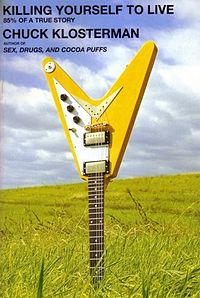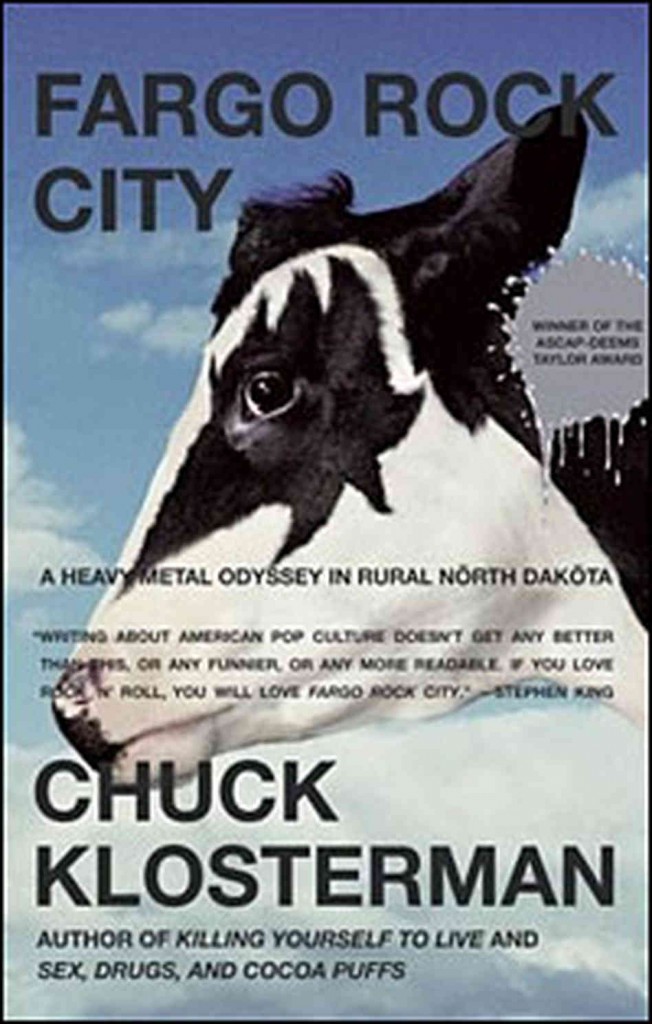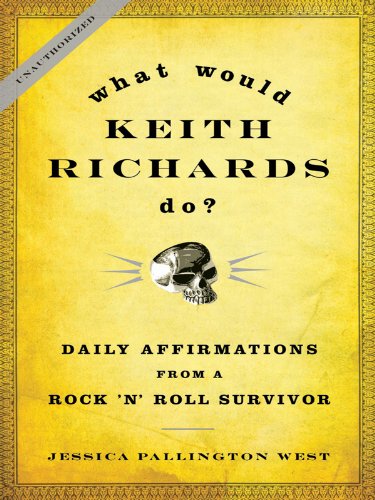
R
Rocky – I finally showed Zen Rocky for the first time; for Naoko and I it wasn’t the first time, but there were so many scenes we’d forgotten it was like seeing it for the first time. Wow!!
The opening fight takes place under the eyes of Jesus, the story unfolds slowly and we get a sense of what kind of guy Stallone’s Rocky is – somber, not so smart, with a heart of gold. He’s also hard to understand, and a lot of the films dialogue is buried in murk – we only really get to understand what anyone’s saying when Apollo Creed comes into the picture, with his “be a thinker, not a stinker” appeal to kids to put their energy into study and not sports (and Creed himself seems to be a bit of an academic/bookworm – we see him reading, we never see him training… quite the opposite to Rocky himself). One significant scene shows a Creed associate watching a TV interview of Ricky slugging the beef, a look of concern crossing his face; he calls Creed to come over and have a look, but Creed’s not interested – he thinks the fight with Rocky is going to be a walk in the park and he’s more interested in business matters – a near-fatal, arrogant mistake. There’s also no big music until 80 minutes into this 120 minute movie, and that’s when we hear first a big 70s funk them, and finally the gigantic themes that we have for so many decades associated with triumph – THE ROCKY THEME!!! Love it all.
The movie is full of great dialogue:
Marie: Hey Rocky – screw you, creep-o.
Apollo Creed: Apollo Creed versus the eye-talian stallion. Sounds like a goddamn monster movie.
Adrienne: Hey, it’s Thanksgiving.
Rocky: To you. But to me it’s Thursday.
Mickey: Like the Bible says, you ain’t gonna get a second shot.
Mickey: Women weaken legs.
Mickey (to Rocky): Eat lightning and crap thunder.
Great famous scenes, like when Rocky puts the five raw eggs into the big cup and drinks them right down – gulp! The running and training scenes and the big triumphant climb up the steps. Rocky’s entire courtship of Adrian, and the turkey-out-the-window scene that moves it forward. Mickey confronting Rocky in his apartment, talking about the 1923 fight with passion and despair, Rocky’s rage to the empty room and his reconciliation with Mickey. Pauly’s rage at Adrian, Adrian’s rage at Pauly. Apollo Creed giving his energy to the crowd with his showmanship while Rocky watches, bemused and a bit disgusted. Creed’s muscles are amazing and compact – Carl Weathers in his prime!! The fight is only 10 minutes at the end of the movie, and is supposed to cover a full 15 rounds, but what insanity, what madness, especially that first devastating punch, the punishment, the lancing of the bloated eyebrow, and the ultimate finale, with the “ADRIAN!!!! ADRIAN!!!!” Wow… what a movie!!!
This edition comes with plenty of extras:
- a commentary track (which my system played through the sub-woofer, which meant I couldn’t understand anything). There was a cool 12-minute video collection of 8mm films made by director John Avildsen that shows Stallone training with Carl Weathers, silently. Interesting test case, and Avildsen talks about using the 8mm to experiment and save the actors embarrassment, a blueprint, a sketchpad, try out lenses, angles, lighting, and to show Sly how heavy he was. There was a lot of rehearsal time for the fight scenes. They learned from a fighting script that Sly wrote out for them, had six weeks of prep, the entire film had a short schedule and budget of $900,000. Wanted a soundtrack like Beethoven’s 6th, which they’d play during the 8mm screenings. The 8mm clips showed a body guide, they did all the cringing early so that there’d be no cringing when the dailies came in. Sly and Carl Weathers are shown with their swollen-face make-up.
- an 8-minute tribute to Burgess Meredith, which talks about how he had been making films since the 1930s, and his performance exceeded all of Sly’s expectations, with a great voice. Burt Young reminisced how they got nominated together. Carl Weathers describes the meeting in Rocky’s apartment. Lee Grant went out with Meredith to an Indian guru show, talks about their escape speeding down the highway (not sure why this is included). Burgess Meredith, 1907-1997. Only Sly’s face is seen, all others are off-screen narrating.
- tribute to James Crabe for 3 minutes, mainly the director talking about his talents as a cinematographer on their 12 movies together, starting (ironically) with Save The Tiger. Opening scene in grim club shows Jimmy’s genius – shades and darkness. Always finding solutions to tricky camera problems. Was nominated for his work in The Formula, not Rocky. 1931-1989.
- a teaser trailer and trailers for Rocky I, Rocky II, Rocky III, Rocky IV and Rocky V. Great! Cheezy announcing like “You can compare him to Nicholson, DeNiro and Brando. But he is Rocky!!” “His name is Sylvester Stallone, but you will always remember him as Rocky!”
- three original TV spots, two of 30 seconds, one of 60 seconds
- a commentary of 28 minutes with Sylvester, recounting how he went to Hollywood and was trying to make it, rented a small room, from which he could open the window and close the door without leaving his bed. Wrote and wrote. Was with Butkus his dog. Saw Muhammad Ali fight Chuck Wepner, the Bayonne Bleeder, who knocked Ali down. This put him into a writing frenzy, and three days later he had a script, 10% of which remained after the rewrites produced the final script. The original screenplay was very dark, with an anti-hero who throws the fight, Mickey is angry and racist. Rocky doesn’t want to be part of that world any more. Too angry and unrepentant. Stallone got a break at a casting call when he mentioned he’s a writer. “Come back later.” The studio liked the script, but didn’t want Stallone in it – Ryan O’Neill, maybe, or Burt Reynolds. “My $40 car had just blown up, so I was taking the bus to work.” Lots of injuries during the production, knuckles flattened out punching beef – beef is hard! Stallone’s dad is bell ringer, brother doo-wop singer. Talia Shire was one of the last choices for Adrian. Sly describes characters and motivations to the film, back stories. They had wanted to use Ken Norton for the Apollo Creed role, but lucked out with Carl Weathers. “Mr Avildsen, I could do better if I had a real actor reading with me,” he said. “Carl, that’s Rocky, the writer and star.” “Well, maybe he’ll get better.” Nice – that’s the attitude we want for this movie! Stallone talks about his dog Butkus’ “train flatulence.” Recounts the original ending for Rocky, where he’s looking for Adrian finds her backstage, gives her a light hug, picks up a flag, they fade into the distance. Describes the process of deciding the final freeze frame.

R2
Rocky II – The sequel to the great film doesn’t live up to the original (it can’t), but is still pretty good – nice dialogue, great performances, wonderful chemistry, even if it does at times feel a bit patched together and the plot is a bit too hook-driven. Of course, there’s nothing mistaking the fact that the first one hour and 45 minutes only exists to bring us the final 15 minutes of the Rock Balboa vs Apollo Creed title fight… but what a final 15 minutes!!!
The film has a rushed-together feel to it, with lots of filler – the first five minutes are a replay of the final five minutes of the first Rocky movie (as if anyone needs a reminder!!), and then there’s a long ambulance-driving sequence as the credits roll, and later some crazy scenes from the hospital, with an enraged, testosterone-driven Apollo Creed ready to carry on the fight right there from his wheelchair! Rock is relaxed and charming about it, talking from a face that’s nothing more than clobbered, raw meat, from which emerge highly refined lines of great dialogue in an impromptu press conference:
What were you thinking as you went into the last round, Rocky?
That I should have stayed in school.
Rocky, do you have brain damage?
I don’t see any.
There’s a great “did you give me your best?” scene in the hospital, and then it’s back to life – marriage, showing off, throwing around money, the money starts to run out, then there’s the reputation. The injured eye is a problem, but after a while it isn’t. Taunts and threats and treaties and training ensue. The film picks up the tiger imagery – the snow tiger at the zoo when Rocky proposes to Adrian, his tiger jacket; it also props up the religious imagery – Rocky’s prominent necklace cross, praying before the fight (twice), getting the priest to bless his fight, getting married in an Italian ceremony in the church. Scenes with bad jokes, like the “condominium – I never use them” joke give the feeling that there’s plenty of filler here. With his impulse shopping and bad driving (and lying about it), we see a side of Rocky we couldn’t see in the first film, when he never ever had any money. Bad commercials and comic relief as Rocky dresses up in proto-Rambo gear that’s maybe more mock Fred Flintstone.
Another area where the second film is different is in its music – they had seven times the budget, and some of that clearly went into music – there’s great new music in the first half, as well as the second (the first film had practically no music in the first half). I know that this is only a story, but it’s still pretty weird to think that he actually named his turtles Cuff and Link!
Great chicken chasing scene with Mickey – the film really amounts to a bit of charm, some drama, and a touch of actual fighting. At weigh-in, we learn that Rocky is 205 pounds, Apollo Creed 225 pounds. “Undefeated anywhere in the world.” This time around we see Apollo Creed’s wife/girlfriend, cementing that part of his relationship (even though we don’t see her again). The fight plays around with cinematography a bit, including slow motion scenes, culminating in those scenes, where he thanks everybody (God included) … except his wife!
A flawed but fun film!
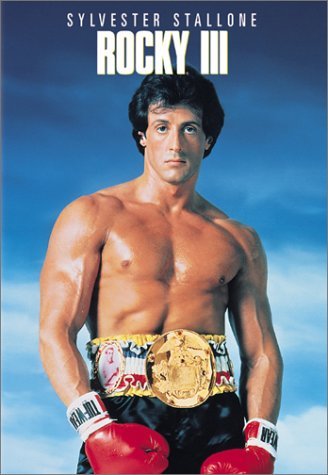
RIII
Rocky III – I had to watch this one last, because it wasn’t available in Singapore! Luckily, Amazon had it, ha ha… The film doesn’t disappoint, as it has all of the trademark Rock items – hamming-it-up comedic scenes (the nutty endorsements), training sequences, a passionate speech by Paulie-the-loser, a motivational speech by Adrian, a recap of the final moments of the previous film, crustiness from Mickey, personal tragedy, irony (Apollo’s “it’s too bad we gotta get old” comment), fall-and-recovery, and that indomitable Rocky spirit. It’s also got music, both good and bad. And great dialogue:
- You’re just a jealous, lazy bum.
- You ever fought a dinosaur?
- No, not lately.
- What does this guy eat for breakfast?
- 202 pounds.
- Huh?
- [announcer] And weighing in at 202 pounds… the heavyweight champion of the world… Rocky Balboa!
- You’re going to wear your anatomy on the outside. Nobody does this much for charity.
- Bob Hope does.
- That’s true
- The ultimate man… versus the ultimate meatball.
- [Rocky Jr] What happened to Goldilocks?
- [Paulie] Bot busted for trespassin’, 30 days in the cooler.
- [Rocky] Nice, Paulie!
- Can he swim?
- With a name like Rock?
- There is no tomorrow.
One of the things that’s missing is the run-up-the-stairs sequence, but they cover that off with the unveiling of the Rocky statue on the same steps.
The Hulk Hogan cameo if hammy, but fun.
Nice film, even it it’s not as good as the previous ones.

RIV
Rocky IV – The movie starts with good times, Rocky and Apollo getting in the ring to spar, with some famous last words from Apollo: “You know, Rocky, it’s too bad we gotta get old.” The early part of the film is goofy, with Pauly gagging around with a pet robot; not too long, though, as we see the entrance of Drago, who quickly gets his bout with Apollo. Great scene of a bewildered Drago in the ring in Las Vegas, James Brown in full American glory, Apollo entering the ring in full bombast, Rocky mugging for the camera, looking dopey. The crowd booing Drago. Paulie’s “I’m the un-silent majority!” The movie is dark, very dark. “You can’t win.”
Unfortunately, the music in this film is especially bad, but with all the new junk there’s a big play on the past – we get another montage from past films, with lots of emphasis on Mickey and the importance of values. “Doin’ that one more round when you don’t think you can is the most important thing in life.” Rocky and Adrian have one of their many emotional speeches, this one on the stairs:
Adrian: You’ve seen him, you know how strong he is. You can’t win!!
Rocky: Adrian, Adrian… always tells the truth. Maybe I can’t win. Maybe the only thing I can do is take everything he’s got. But to beat me, he’s gonna have to kill me. And to kill me, he’s gonna have to have the heart to stand in front of me. And to do that, he’s got to be willing to die as well. I don’t know if he’s ready to do that.
Then we get the famous training montage, with very little humour at all, just majesty as Rocky conquers nature, in contrast with Drago who conquers science and machines. Paulie gives a great speech as Rocky and Adrian are heading out to the ring:
Paulie: Rocko, I know you’re kinda busy just now, but I wanna tell a something I never told ya before. I know that sometimes I act stupid and say stupid things, but you kept me around when other people would have said ‘drop that bum’. You gave me respect; y’know, it’s hard for me to say these kind of things, because that ain’t my way, but if I could just stop being myself and step out and be someone else, I’d wanna be you. You’re all heart, Rock!
[kiss on cheek]
Rocky Thanks, Paulie.
Paulie: Now blast this guy’s teeth out!!
Rocky: I’ll try.
Rocky in the ring – “I see three of him out there.” “Hit the one in the middle.” Later, cracks appear in Drago’s invulnerability, “He’s a man”, they realise. For Drago, it’s the opposite: “He’s not human. It’s like hitting an iron plate.” Drago begins to bleed from below both eyes, and then things begin to go bad for him. Ouch!! At the end, Drago shows his ambition and his selfishness, and Rocky gives his great “Everybody can change” speech. Nice!
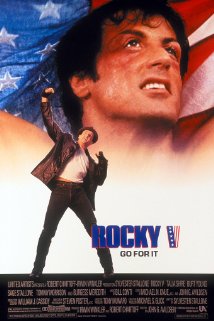
RV
Rocky V – Starts off with a naked Stallone in the shower, the only time in the whole film we’ll see any of Rocky’s famous physique (this film is in many ways different – there’s no big title bout at the end – but it also falls back to the tried and true as they go back to their old neighbourhood after losing all of their millions and wander the tough, brawling streets of the first two movies). Rocky faces a nasty press conference and deals with an aggressive fight promoter George Washington Duke (full on the Rocky tradition of giving guys tough names – hey, who gave that man a mic?!?), then we see him briefly in his own home, before he loses everything. Wow! Rocky has a cool interaction with his son (Stallone’s real-life son Sage Stallone), with his drawing of his French teacher Madame Dupont. Nice speech about his raccoon eyes, and how seeing his son was like seeing himself born again (sad to reflect that Sage himself died in 2012, and Stallone lost his first son – while Sage did a great job in Rocky V, Stallone cast another as his son in Rocky Balboa in 2008, a sign that things were not right). “Every day you learn something new and every day I forget something new. Listen, we’re in this thing together.”
As he’s moving out, he finds his old enforcer clothes (gloves, hat), and he slips casually back to his old self as a local neighborhood guy, Adrian takes up her old job in the pet shop (and wears her old glasses)… only Rocky Jr needs to fend for himself again on the mean streets (which he does eventually). Flashback to Mickey’s cufflinks speech, angel on his shoulder, living and dying, “heart, not muscle” speech. Crazy taunting from outrageous promoter George Washington Duke, “do you like reaching in your pocket and only feeling your leg?” Drama!!!!
The screenwriters also has a clear a penchant for giving his characters totally silly names, and the prize fighter Tommy Gunn is no exception (he’s even called “the Machine” Gunn as a ring nickname – how original!!). Rocky’s early speech to Tommy about fighting is embarrassing, he really sounds like an old fighter who’s beginning to lose his marbles (I’m sure that’s completely intentional, of course). Rocky and Adrian shout and cry at each other in a series of dramatic speeches. In a return to the original, Rocky gets the priest’s blessing from the window, they recreate the opening scene of the face of Jesus looking down upon the boxers (nice touch – it could be cheezy, but it works well).
But it all falls apart, and soon Tommy Gunn tells Rocky “It’s my way or the highway,” from behind the wheel of his sports car (pure cheese, which shows what a piece of work he is). Great hostile post-title fight scene. Pretty soon, we see George Washington Duke (with his awesomely huge glasses), and realise that his plan has actually come together – it was to play up to Tommy’s ego and eventually to draw Rocky out to take on a neophyte champion. They have a beautiful street brawl, and it’s heartbreaking to see Rocky finally coming to terms with what a scumbag Gunn is. Great tripping action and all sorts of yucky nonsense. The denouement is beautiful too: “You’re going to love Picasso.” “Yeah? Well, I love almost everybody.” Unfortunately, the movie ends with a lame and unforgettable Elton John ballad (never thought I’d be sentimental for Survivor – thanks, Elton, for not coming through), but by now nobody cares – Rocky has won the day!!

RB
Rocky Balboa – “Time goes by too fast.” A film of many small episodes, it’s like a collection of short stories that characterise most of the Rocky films, and the little stories that make up the life of Rocky Balboa, the people in his life, and the working class city of Philadelphia. In the opening scenes, we see Cuff and Link, Rocky’s turtles, Adrian has died of cancer (“It was woman’s cancer.” “She was a great girl.” “The best.”) We see Rocky interacting with the neighborhood people, and perhaps Stallone is wishing for this kind of a simple life (he seemed to have a great time filming it, as we see from the documentary footage on the DVD). Lots of great idiot savant wisdom from Paulie. “If you live some place long enough, you are that place.”
And so… we take a tour of the shattered parts of that place, including the destroyed ice rink. Rocky Jr is now an investment banker (shades of Oliver Stone’s Wall Street?), and a potential new romance with Little Marie (the “screw you, creep-o” girl from the first Rocky film), and Rocky trying to become friends with her son, Step; they get a dog, call it Punchy, and young Step features less and less in the story (a short story that ran its course?). Interactions with Rocky Jr are painful – he’s a selfish ass, and not up to much in life. What does he get from avoiding his father? This all leads to a dramatic confrontation speech and more actifying:
The world ain’t all sunshine and rainbows. It’s a very mean and nasty place and I don’t care how tough you are – it will beat you to your knees and keep you there permanently if you let it. You, me and nobody is going to hit as hard as life. But it ain’t about how hard you can hit, it’s about how hard you can get hit and keep moving forward, how much you can take and keep moving forward. That’s how winning is done. Now if you know how much you’re worth, then go out and get what you’re worth, but you gotta be willing to take the hits, and not point the finger saying you ain’t where you wanna be because of him or her or anybody; cowards to that and that ain’t you. You’re better than that.
The reunion stuff is not as convincing as it was in Rocky V (and even then it wasn’t very convincing). But the story of Rocky is not really about the dominance of these minor characters, it’s about the majesty of Rocky the icon – the other characters hardly matter. Even the champ (played by real-life light heavyweight champ Antonio Tarver!) he fights is uninteresting, bathed in glaring light (the whole movie is shot in ugly halogen light). The drama of getting there is more interesting, and this included a battle with the boxing association about his license:
It’s your right to listen to your gut, it ain’t nobody’s right to say no after you earned the right to be what you wanna be and do what you wanna do. The older I get the more things I gotta leave behind. That’s life. The only thing I’m asking you guys to leave on the table is what’s right!
Of course, there’s still a training sequence, and this time Rocky gags when he tries to drink the raw eggs. Oh well! Of course, when he’s ready to fight, Rocky comes out with Sinatra’s “High Hopes” as his theme song, totally anticlimactic to the champ’s gangsta rap theme. Sheesh!! Mike Tyson has a cool cameo – Mike!! Dixon hurts his hand on Rocky’s head making the intra-generational battle more realistic. The film ends, and it’s the end of an era. Stallone somehow managed to catch the mood of the times and slip this one in – an era with no deserving champion, a real champion of a bygone era stands a chance to fight the reigning champ to a standstill. Everything’s good, the sport gets a nudge, the Rocky fanatics get their fix, the champ gets some publicity, everybody’s happy. You just have Stallone putting his heart into the film like always, and that’s what we want to see. Paulie even gets a nice speech:
It takes guts climbing in that ring when yo know you’re gonna take a beating. You’re gonna do alright, Rocko.
How do you know all that?
The stuff in the basement
Nice.
The film has eight deleted and alternate scenes, including one alternate ending – In one Paulie paints a picture of a dog that has been shot between the eyes, and we hear him complaining about 31 years in the plant, while Rocky is asked to wear a hairnet in the meat locker (!!!); Rocky gagging on the raw eggs, cleaning Paulie’s room; alternate scene to meeting Little Marie in the bar; awkward scene with Step – “I was teachin’ myself to be uncomfortable; I thought it might come in handy.” “Mothers should be goof-proof.” Paulie crying in the alley when he was fired; sparring to opera music; alternate ending where Rocky gets the decision. Goofy boxing scenes where the guys are smirking.
The set also comes with a “making-of” documentary that goes through the various motivations for Sly to make this film, and what got it going. It was the story – “the last thing to age is the heart.” The script was finished in 2005, and then it went forward. “You haven’t peaked yet?” “I still got some stuff in the basement.” Scene with John F Street, the mayor of Philadelphia. The extra features also shows full virtual battle (not very interesting), as well as the work that went into rendering this stuff (more interesting). Nice stuff!!

